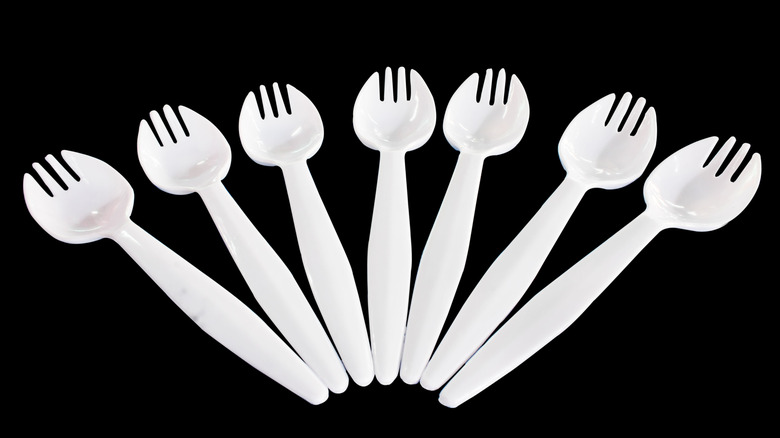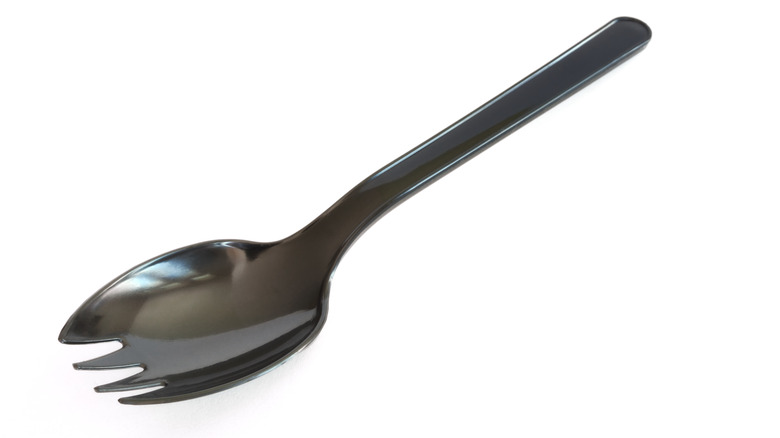We Have KFC To Thank For The Success Of The Spork
Change doesn't come easy, something clearly evidenced by silverware. While knives and spoons are among the oldest human tools, subsequent developments have been slow to catch on. Forks were once considered "too feminine," elitist utensils for dainty women of means, and it took centuries for them to break past the barrier of fragile masculinity. From the fork's struggle alone, we should have learned that innovations in flatware are risky endeavors, but one utensil keeps challenging this logic: the spork. The spork has been centuries in the making, and even though it hasn't been as widely adopted as forks, spoons, or knives, its quirky, multifaceted nature has earned it a special place in our hearts. However, the spork would probably never have gotten where it is today without a bit of help from the biggest name in the chicken game: KFC.
Before we get there, let's start by dispelling a popular rumor about the spork's origins. An oft-repeated story says that General Douglas MacArthur conceived of the spork while overseeing United States military operations in Japan during the 1940s. It is said that MacArthur had a vehement hatred of chopsticks and wanted to push Western utensils onto the Japanese. However, he feared that prisoners of war could use the long tines of forks as weapons against their American captors, so he thought of something with shorter prongs: a fork-spoon hybrid. Though entertaining, there is no truth to this tale. In fact, the spork was born all the way back in medieval times.
The origins of the spork
The earliest example of a fork-spoon hybrid appears to have come from medieval Europe. It was delightfully termed the sucket fork, and it looked very different from the modern spork. Sucket forks were double-sided, with prongs on one end of the handle and a spoon on the other. They were used to eat desserts, the fork end for spearing small sweets, and the spoon end for scooping sugary syrups. The 1800s saw the emergence of terrapin forks, which were designed for the purpose of eating turtle meat and spooning up the thick broth it was often served in. The terrapin fork bears a remarkable resemblance to the modern spork, attaching the fork tines directly to the spoon head. This was followed by a similar utensil called the runcible spoon, which was ideal for eating mincemeat since it could spear larger chunks while scooping the more finely-ground bits into the same bite.
The first patent for hybrid flatware was filed in 1874 by Samuel W. Francis of Rhode Island. He had invented a combination fork, spoon, and knife, which was essentially a modern spork with a blade on one side. In the 1940s, an Australian named William McArthur invented a similar three-in-one utensil known as the Splayd. It became a popular novelty gift in subsequent years, and it's possible that a misunderstanding around this time led to the spork's association with the other '40s MacArthur. However, the word "spork" actually appeared as far back as 1909.
Fast food brought the spork to prominence
The spork achieved its modern form in 1970 when the Van Brode Milling Company, which supplied rations to the U.S. military, patented the invention we know so well today. Not only that, but they trademarked the term 'spork'. However, Van Brode later dropped their trademark, and in 1975, the U.K. brand Plastico Limited patented their own spork. Both companies used plastic, whereas earlier inventions like the terrapin fork and the Splayd had been metal. This established cheap versatility as the spork's calling card, and it made the new utensil a perfect fit for the burgeoning fast food industry. The enigmatic Colonel Sanders (yes, he was a real guy), was one of the first to recognize the potential in plastic sporks, so all the way back in the 1970s, he made it the go-to utensil at all of his restaurants.
KFC popularized the spork's two-in-one powers, firmly cementing the tool in the zeitgeist, and carrying it to iconic status. However, other people have continued to tinker with multi-utensil hybrids, and if one of these new developments catches on, it could totally transform our perception of what a spork can do. In the mid-2000s, Swedish designer Joachim Nordwall released a new spork through the camping supply brand Light My Fire. In an attempt to improve on the shortcomings he saw, Nordwall placed the spoon and fork heads on opposite ends of the handle, bringing history full circle back to the days of the sucket fork.


